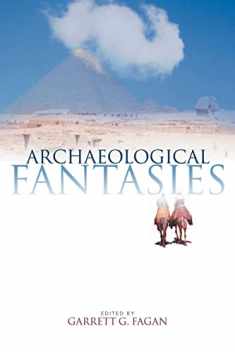
Lost City, Found Pyramid: Understanding Alternative Archaeologies and Pseudoscientific Practices
ISBN-13:
9780817319113
ISBN-10:
0817319115
Edition:
First Edition, First
Author:
David S. Anderson, Jeb J. Card
Publication date:
2016
Publisher:
University Alabama Press
Format:
Hardcover
272 pages
FREE US shipping
Book details
ISBN-13:
9780817319113
ISBN-10:
0817319115
Edition:
First Edition, First
Author:
David S. Anderson, Jeb J. Card
Publication date:
2016
Publisher:
University Alabama Press
Format:
Hardcover
272 pages
Summary
Lost City, Found Pyramid: Understanding Alternative Archaeologies and Pseudoscientific Practices (ISBN-13: 9780817319113 and ISBN-10: 0817319115), written by authors
David S. Anderson, Jeb J. Card, was published by University Alabama Press in 2016.
With an overall rating of 3.7 stars, it's a notable title among other
Ancient & Controversial Knowledge
(Occult & Paranormal, History & Philosophy) books. You can easily purchase or rent Lost City, Found Pyramid: Understanding Alternative Archaeologies and Pseudoscientific Practices (Hardcover) from BooksRun,
along with many other new and used
Ancient & Controversial Knowledge
books
and textbooks.
And, if you're looking to sell your copy, our current buyback offer is $1.43.
Description
Lost City, Found Pyramid delves into the fascinating world of sensational “pseudoarchaeology,” from perennial discoveries of lost pyramids or civilizations to contemporary ghost-hunting and reality TV. It examines how nonscientific pursuit of myths and legends warps both public perceptions of archaeology and of human history itself.
A collection of twelve engaging and insightful essays, Lost City, Found Pyramid does far more than argue for the simple debunking of false archaeology. Rather, it brings into focus the value of understanding how and why pseudoarchaeology captures the public imagination. By comprehending pseudoarchaeology’s appeal as a media product, cultural practice, and communication strategy, archaeologists can enhance and enliven how they communicate about real archaeology in the classroom and in the public arena.
The first part of Lost City, Found Pyramidprovides numerous case studies. Some examine the work of well-intentioned romantics who project onto actual archaeological data whimsical interpretative frameworks or quixotic “proofs” that confirm legends, such as that of the Lost White City of Honduras, or other alternative claims. Other case studies lay bare how false claims may inadvertently lead to the perpetuation of ethnic stereotypes, economic exploitation, political adventurism, and a misunderstanding of science.
Offering much of interest to scholars and students of archaeology, archaeology buffs, as well as policy-makers involved in the discovery, curation, and care of archaeological sites and relics, Lost City, Found Pyramid provides an invaluable corrective and hopeful strategy for engaging the public’s curiosity with the compelling world of archaeological discovery.
A collection of twelve engaging and insightful essays, Lost City, Found Pyramid does far more than argue for the simple debunking of false archaeology. Rather, it brings into focus the value of understanding how and why pseudoarchaeology captures the public imagination. By comprehending pseudoarchaeology’s appeal as a media product, cultural practice, and communication strategy, archaeologists can enhance and enliven how they communicate about real archaeology in the classroom and in the public arena.
The first part of Lost City, Found Pyramidprovides numerous case studies. Some examine the work of well-intentioned romantics who project onto actual archaeological data whimsical interpretative frameworks or quixotic “proofs” that confirm legends, such as that of the Lost White City of Honduras, or other alternative claims. Other case studies lay bare how false claims may inadvertently lead to the perpetuation of ethnic stereotypes, economic exploitation, political adventurism, and a misunderstanding of science.
Offering much of interest to scholars and students of archaeology, archaeology buffs, as well as policy-makers involved in the discovery, curation, and care of archaeological sites and relics, Lost City, Found Pyramid provides an invaluable corrective and hopeful strategy for engaging the public’s curiosity with the compelling world of archaeological discovery.


We would LOVE it if you could help us and other readers by reviewing the book
Book review

Congratulations! We have received your book review.
{user}
{createdAt}
by {truncated_author}



